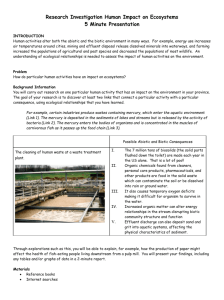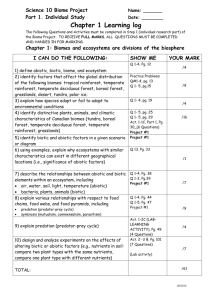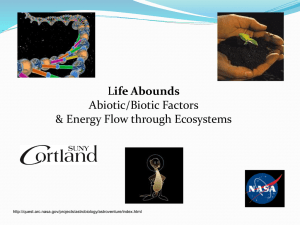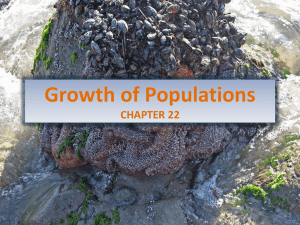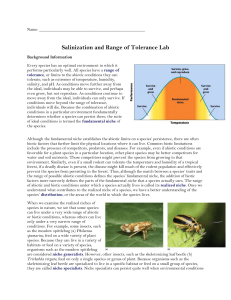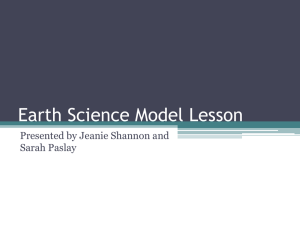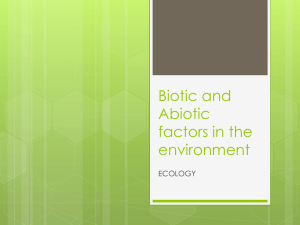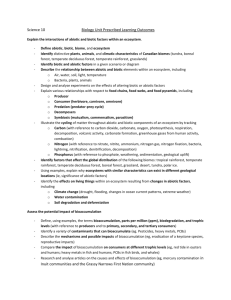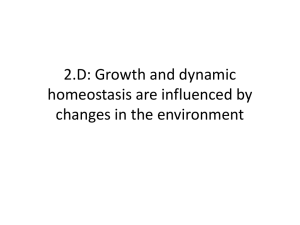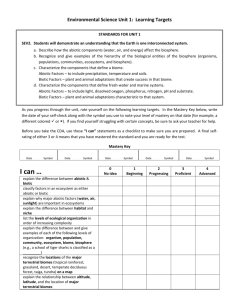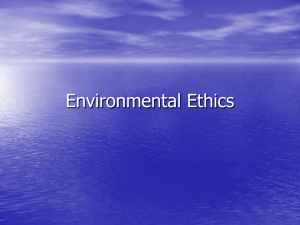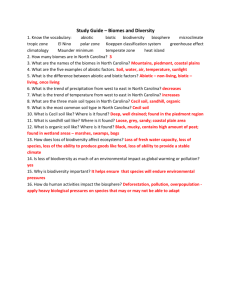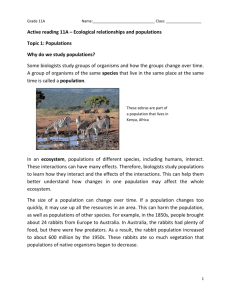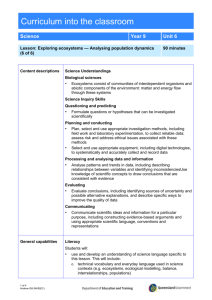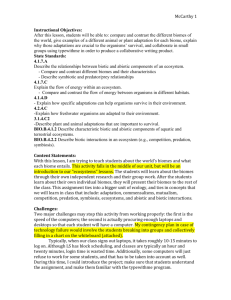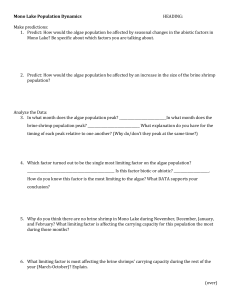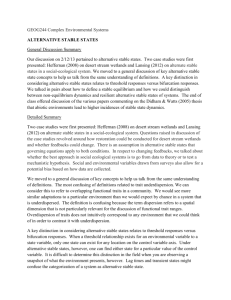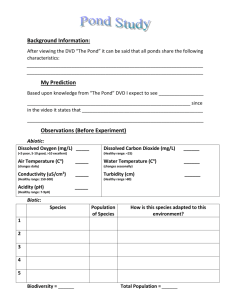Unit 1 WTK ecology ap
advertisement
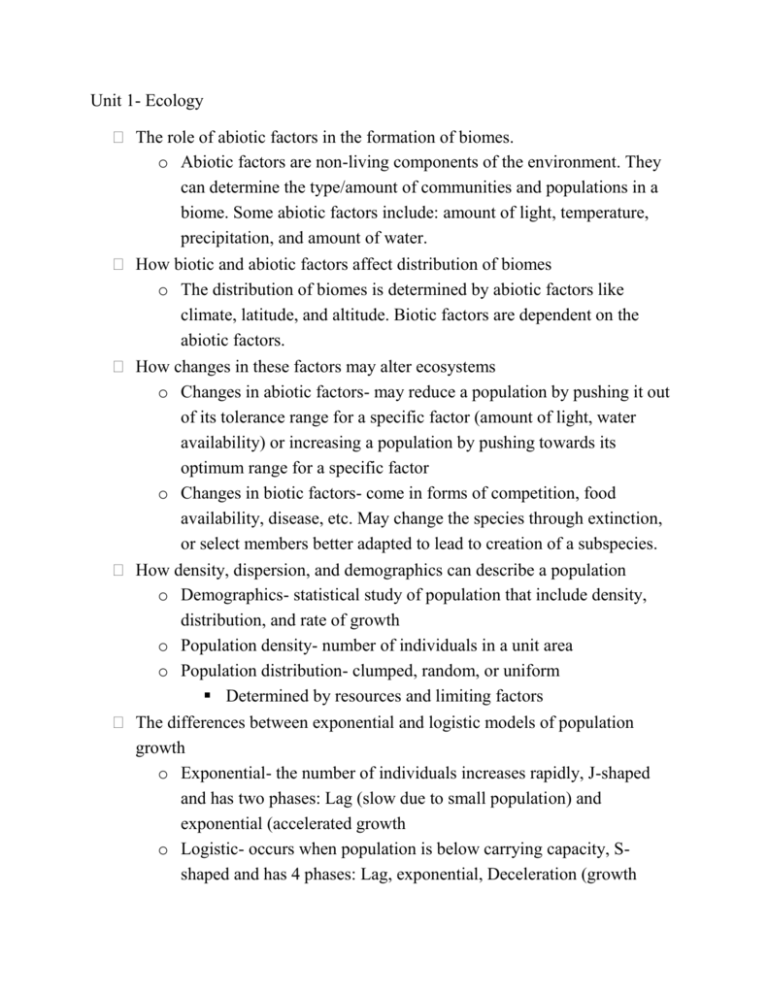
Unit 1- Ecology The role of abiotic factors in the formation of biomes. o Abiotic factors are non-living components of the environment. They can determine the type/amount of communities and populations in a biome. Some abiotic factors include: amount of light, temperature, precipitation, and amount of water. How biotic and abiotic factors affect distribution of biomes o The distribution of biomes is determined by abiotic factors like climate, latitude, and altitude. Biotic factors are dependent on the abiotic factors. How changes in these factors may alter ecosystems o Changes in abiotic factors- may reduce a population by pushing it out of its tolerance range for a specific factor (amount of light, water availability) or increasing a population by pushing towards its optimum range for a specific factor o Changes in biotic factors- come in forms of competition, food availability, disease, etc. May change the species through extinction, or select members better adapted to lead to creation of a subspecies. How density, dispersion, and demographics can describe a population o Demographics- statistical study of population that include density, distribution, and rate of growth o Population density- number of individuals in a unit area o Population distribution- clumped, random, or uniform Determined by resources and limiting factors The differences between exponential and logistic models of population growth o Exponential- the number of individuals increases rapidly, J-shaped and has two phases: Lag (slow due to small population) and exponential (accelerated growth o Logistic- occurs when population is below carrying capacity, Sshaped and has 4 phases: Lag, exponential, Deceleration (growth slows as carrying capacity is neared), and stable equilibrium (little to no growth) How density-independent and density-dependent factors can control population growth o Density dependent- operates in populations living at a density near the limit imposed by their resources where competition is stronger among individuals o Density independent- occurs in populations well below carrying capacity How a change in matter or energy will affect the population or community o Less energy leads to a lower population o All living things require energy o Changes in amounts of producers affects all organisms The effect of age distributions and fecundity on human populations as presented in age-structure pyramids o Pre-reproductive numbers being the highest results in a higher birthrate than death rate. More individuals entering reproductive stage then leaving, results in population growth. o Population stabilize when all stages are relatively equal in number, with post-reproductive being slightly smaller. o Post reproductive having largest numbers results in higher death rate, more individuals leave reproductive phase than enter, creates population decay o Higher fecundity= higher fertility rates, results in more offspring and therefore either greater growth or smaller decay The difference between a fundamental niche and a realized niche o Fundamental- where a species can survive o Realized- where a species actually survives when biotic conditions are present The role of competitive exclusion in interspecific competition o No two species can occupy the same niche at the same time. Through interspecific competition, when different species try to use the same resources, there is competitive exclusion so only 1 species will be involved in that niche. The symbiotic relationships of parasitism, mutualism, and commensalism o Parasitism- one organism benefits at the expense of the other o Mutualism- both participants benefit o One organism benefits, one is neither helped nor harmed The impact of keystone species on community structure o Keystone species- activities significantly affect community structure o Grizzly bears in northwestern US- disperse seeds, keep smaller hoofed animal populations under control, move soil when they dig up roots The difference between primary and secondary succession o Primary- formation of soil from exposed rock due to wind, water, etc. Occurs where there is no base soil. Ex- volcano, glacial retreat o Secondary- disturbance based on progressive change from grasses to shrubs to trees. Occurs where soil is already present. Ex- cultivated field returning to normal state How energy flows through the ecosystem in relations to food webs and food chains o Food webs- diagrams that describes trophic (feeding) relationships, Shows various interconnecting paths, Grazing begins with a producer o Food chain- show a single path of energy flow in an ecosystem o Shows trophic relationships The difference between gross primary productivity and net primary productivity o Gross primary productivity- total amount of energy harvested by producers o Net primary productivity- total amount of energy harvested by producers minus amount they use to produce energy. The carbon and nitrogen biogeochemical cycles How biogeochemical cycles impact individual organisms and/or populations and ecosystems o Water- necessary for life o Carbon- necessary for photosynthetic organisms o Nitrogen- limiting plant nutrient o Phosphorus-mineral component in bones and teeth The value of biodiversity and the major human threats to it o Biodiversity insures survival of species. Biodiversity is greatest where sunlight is the most abundant and water availability is high. o Threats include burning of fossil fuels and woods, deforestation, oil spills, mining activities, dumping of waste, overexploitation How human actions are changing the Earth o Population growth- Depleting resources, CO2 emissions o Pollution o Depletion of freshwater o Eutrophication o Acid deposition o Greenhouse effect- climate change and global warming How to predict consequences on both local and global ecosystems of specific human activities o Habitat loss- moving, building, deforestation, overhunting, bringing in disease, exotic pets, pollution
